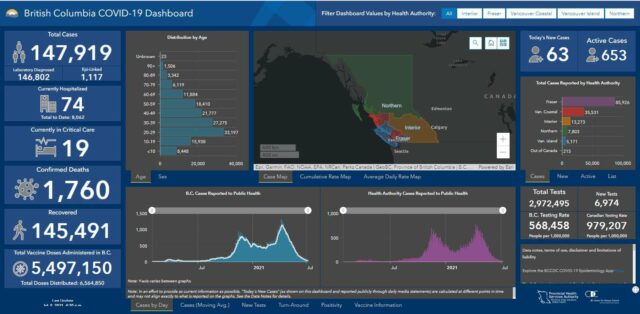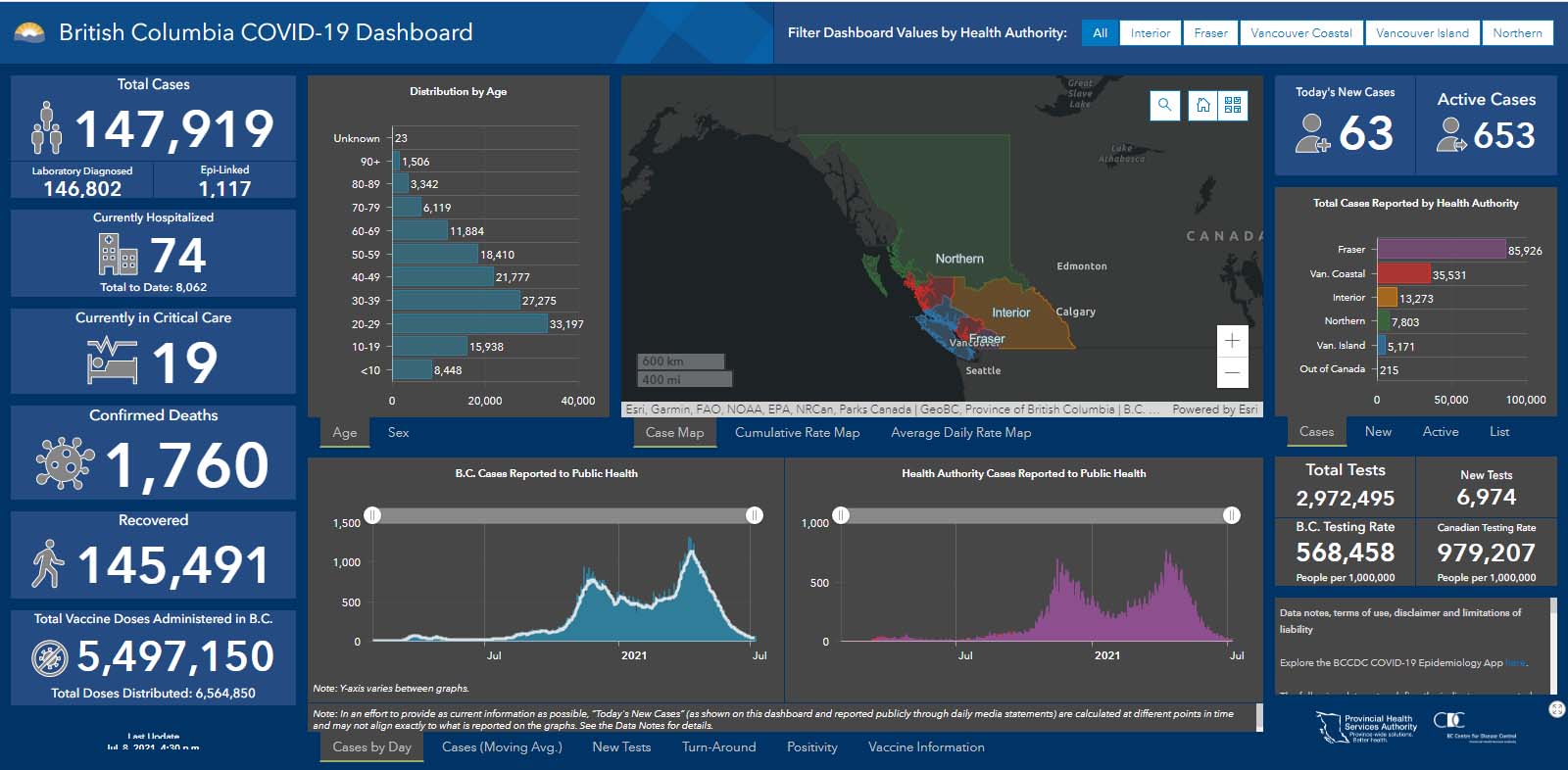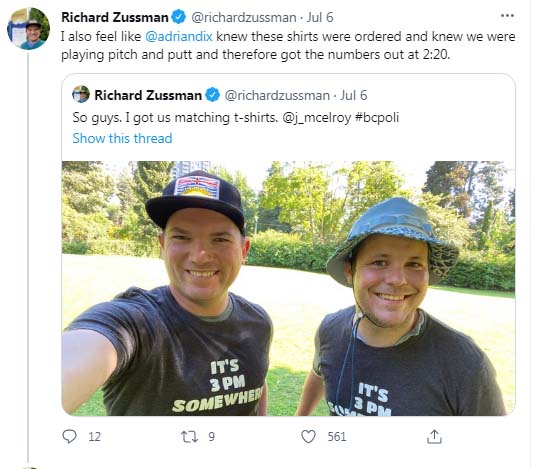
Friday July 9, 2021 | VICTORIA, BC [Updated at 10:35 am & 9:40 am July 10, 2021]
Editorial by Mary P Brooke, B.Sc., Cert PR – Editor | Island Social Trends
Yesterday July 8 was the only day that Provincial Health Officer Dr Bonnie Henry and Health Minister Adrian Dix held a COVID update media session this week. They announced at the end of June that they’d be easing back on the sessions that became weekly for a long while during the pandemic.
At the end of June they seemed upbeat about providing a ‘new format’ of information to media about COVID. What was expected by hard-working media who’ve worked hard ‘in the trenches’ for 18 months covering COVID was something far more substantial than the lightweight “Information Bulletin” format this coming by email to media around 2 pm on weekdays.
The bulletins seem very much back in the realm of being produced by a junior copy-desk communications person in the ministry, far less robust than the details as issued during the pandemic. The details that are presented are rather opaque, for example “since December 2020 the Province has administered 5,497,150 doses of Pfizer-BioNTech, Moderna and AstraZeneca COVID-19 vaccines” — which is so broad and without context that it requires deep journalistic attention and treatment to give it any meaning for readers.

The pandemic is not over:
Yet the pandemic is not over. The current success of the BC reopening of economy and everything else depends entirely upon the success of vaccines themselves and the partnership to that which is the hoped-for success of the BC Immunization plan. Presently the percentage of first-dose vaccine recipients is inching up about 0.1% per day, presently at 78.4% (July 8) for British Columbians age 12+ — falling short of the 80% or greater that is hoped for as community (herd) immunity, and just 40.0% of people in BC age 12+ have received a second dose.
Full vaccination requires two doses, apparently. There is a rush to ‘beat the clock’ as the fall-winter respiratory season looms come September; COVID is now part of that season. Will sensible health precautions stick (physical distancing, frequent hand washing, ditching the handshake for the elbow-bump, and wearing a mask at close range to others)?
The delta variant is of some concern to the medical community, in that the current vaccines may not offer as much protection against that variant of the COVID-19 (SARS-CoV-2) virus. And the virus will keep mutating. It’s a race against time to prevent a fourth wave this winter season.
So the strength and attention to meaningful COVID data still matters.

Data variance:
Perhaps it is just one day’s oops. But probably not. Variance in accuracy between the Information Bulletin as July 8 is a case in point of how it’s far too soon to let up on attention and accuracy during the ongoing COVID-19 pandemic.
The 2 pm release showed Island Health active cases on July 8 as 22 (with seven new) but the dashboard showed 20 active cases (with five new). The 2 pm release showed 59 new cases for BC-wide, but the dashboard showed 63.
Later today (after this article was published), the Health Ministry send us this statement: “While data discrepancies and lags do happen, we are continually working on making our reporting as efficient and timely as possible.” However, if the goal is to get data out to the media mid-afternoon and the BC CDC stats are not finalized until day’s end, it’s not clear how the former can ever be robust enough to report on in both a reliable as well as ‘timely’ manner.
That arrangement of data organization and timing of delivery somewhat implodes the entire process. [Editor’s note: Island Social Trends will wait for the BC CDC stats, and hopefully our readers will not consider this to be ‘late’, even though it’s same-day.]
Provisional vs Most Up to Date:
The Health Ministry says that the numbers in the July 8 statement were “provisional due to a data delay” but that “the numbers currently posted to the BCCDC dashboard are the most up to date”, and that a data correction will be issued to reflect this later today July 9.
Communications standards:
While this is a professional explanation, it falls far short of understanding what the media do with information — particularly information as important as COVID stats. Journalists write to ‘the record of public discourse’. It matters that we are accurate.
If the Health Ministry is pandering to TV media that want their information sooner (some journalists have created a meme around the stats coming at 3 pm and implying that anything later than that is substandard), that’s a poor reason to issue a lightweight bulletin that cannot reliably be assuredly used for permanence.

Furthermore, it takes time and resource and loop back to check and compare the data from the two sources and to correct and update reports as necessary.
Additionally, our readers rely on us to provide accurate information; if there will be regular occurrences of data updates based solely on a perceived need to issue the bulletin “ahead of 3 pm”, that borders on pandering to the media and generates a level of distrust of the data (if not the media outlet) to release data that ends of not being accurate.
Too bad that hard-and-fast media deadlines drive the message (well, as Marshall McLuhan prophetically said back in the 1960s — the medium is the message), but it’s time to get past that.
As well, some media will have more fluidity with the data timing, which puts some media outlets at an advantage over others — for no valid reason.
News media in the digital age:
It’s tough enough to have any measure of process and control over the massive volumes of information and data that crosses an editor’s desk at any time. When it comes to covering the COVID-19 pandemic there has been an additional level of focus and commitment to the ongoing ‘story’.
While the Health Ministry communications department has been hard-working and helpful (even expanding their top-level team from two to four this year, with the additional two focusing on just COVID, just to keep up with the tsunami of data assembly and messaging), it is hoped by media that they remain true to their communications craft in the face of the onslaught of data and the pressures of the government-political realm.
Ultimately communications is about clarity, and one hopes about accuracy to the degree that is possible. Yes, circumstances happen to us all which challenge the excellence of these goals. But it seems not unreasonable to expect of the Health Ministry to set the highest possible bar during a once-in-a-century pandemic, and to not drop the ball just because the apparent peak of the pandemic is behind us. COVID is not over yet. We still need the best possible attention to this ongoing story as it loses top-billing in the news but still matters to the library of information that is effectively generating history in the moment.
===== About the writer:
Island Social Trends Editor Mary P Brooke holds a Bachelor of Science in nutrition and community health education, as well as a second major in Sociology, with a dash of business management thrown in for good measure. She was awarded the McGeachy Prize in Journalism at the University of Saskatchewan, and also holds a Public Relations Certificate earned at the University of Regina. She studied magazine production with Reader’s Digest.
Mary Brooke wrote the inaugural curriculum for the Writing for Business and Journalism program at the Western Academy of Photography back in the 1990s… some of today’s BC Government communications staff were her students and benefactors of that curriculum.
Ms Brooke has built her own publication stream with a focus on socioeconomic and political issues of the west shore, south Vancouver Island, and British Columbia (including national perspectives). The flagship publication is today known as Island Social Trends but began as MapleLine Magazine (quarterly magazine, colour, print only, 2008-2010), morphed into Sooke Voice News (weekly newspaper, distributed widely in Sooke, print & online, 2011-2013), further emerged as West Shore Voice News (weekly newspaper, distributed in Sooke, Langford, Colwood and View Royal as print, plus online PDF, 2014-2020), and in bowing to the pressures of the COVID pandemic went fully digital in 2020 with a name change to Island Social Trends in August 2020.





